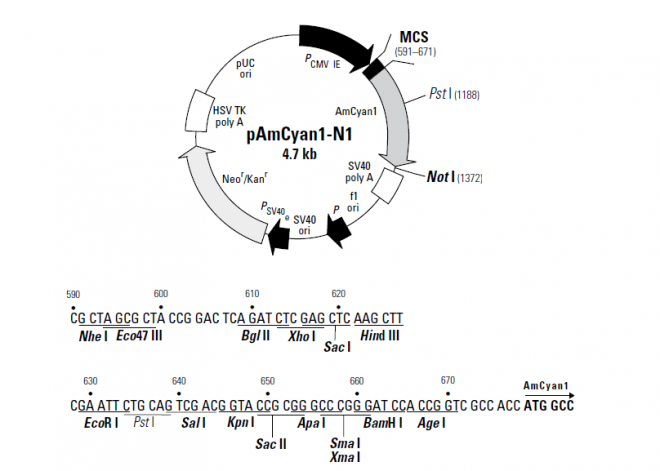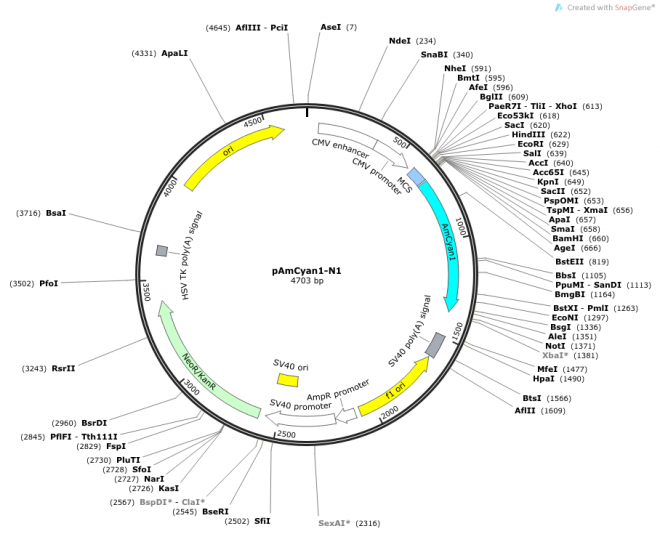pAmCyan-N1 载体
| 质粒类型: | 荧光蛋白报告载体 |
|---|---|
| 启动子: | CMV |
| 载体大小: | 4703 bp (查看载体序列) |
| 载体标签: | AmCyan1 |
| 载体抗性: | 卡那霉素(Kanamycin) |
| 筛选标记: | Neomycin (新霉素) |
pAmCyan1-N1 encodes a human codon-optimized variant of wild-type Anemonia majano cyan fluorescent protein, AmCyan1 (1). The AmCyan1 coding sequence contains a series of silent base-pair changes, which correspond to human codon-usage preferences, for optimal expression in mammalian cells (2). Additionally, an upstream sequence—located just 5' to the AmCyan1 start codon—has been converted to a Kozak consensus translation initiation site (3) to further increase the translation efficiency in eukaryotic cells. Two amino acid substitutions (Asn-34 to Ser; Lys-68 to Met) have been made to enhance the emission characteristics of AmCyan1 (excitation maximum = 458 nm; emission maximum = 489 nm).
The multiple cloning site (MCS) in pAmCyan1-N1 is positioned between the immediate-early promoter of CMV (PCMV IE) and the AmCyan1 coding sequence. Thus, genes cloned into the MCS will be expressed as fusions to the N-terminus of AmCyan1 if they are in the same reading frame as AmCyan1 and there are no intervening stop codons. The SV40 polyadenylation signals (SV40 polyA) downstream of the AmCyan1 gene direct proper processing of the 3' end of AmCyan1 mRNA.
The vector backbone contains an SV40 origin (SV40 ori) for replication in mammalian cells that express the SV40 T antigen, a pUC origin of replication (pUC ori) for propagation in E. coli, and an f1 origin (f1 ori) for single-stranded DNA production. In addition, a neomycin-resistance cassette— consisting of the SV40 early promoter (PSV40e), the neomycin/kanamycin resistance gene of Tn5 (Neor/Kanr), and polyadenylation signals from the Herpes simplex virus thymidine kinase (HSV TK poly A) gene—allows stably transfected eukaryotic cells to be selected using G418 (4). A bacterial promoter (P) upstream of this cassette drives expression of the Neor/ Kanr gene in E. coli host cells, which can be selected with kanamycin.
载体应用
Fusions to the N terminus of AmCyan1 retain the fluorescent properties of the native protein allowing the localization of the fusion protein in vivo . The target gene should be cloned into pAmCyan1-N1 so that it is in frame with the AmCyan1 coding sequence, with no intervening, in-frame stop codons. The inserted gene should include the initiating ATG codon. The recombinant pAmCyan1-N1 vector can be transfected into mammalian cells using any standard transfection method. If required, stable transformants can be selected using G418 (available from Clontech; Cat. Nos. 631307 & 631308). We recommend selecting mammalian cell cultures in 500–1,300 μg/ml G418, depending on the cell line. Be sure to establish a kill curve for each cell line and each lot of G418 to determine the optimal selection concentration. Unmodified (i.e., non-recombinant) pAmCyan1-N1 can also be used simply to express AmCyan1 in a cell line of interest (e.g., as a transfection marker).



